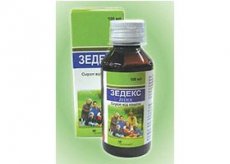Medical expert of the article
New publications
Preparations
Zedex
Last reviewed: 03.07.2025

All iLive content is medically reviewed or fact checked to ensure as much factual accuracy as possible.
We have strict sourcing guidelines and only link to reputable media sites, academic research institutions and, whenever possible, medically peer reviewed studies. Note that the numbers in parentheses ([1], [2], etc.) are clickable links to these studies.
If you feel that any of our content is inaccurate, out-of-date, or otherwise questionable, please select it and press Ctrl + Enter.

The drug Zedex is a combined antitussive agent, belongs to the pharmacological group of drugs used for cough and colds: ATC code - R05F A01 (opium derivatives in combination with mucolytics). Manufacturer - Wockhardt Ltd (India).
Indications Zedex
Zedex is intended for the treatment of unproductive (dry) cough in acute and chronic forms of respiratory diseases (laryngitis, tracheitis, bronchitis, etc.), as well as pneumonia, whooping cough and pulmonary tuberculosis.
 [ 1 ]
[ 1 ]
Release form
Syrup (in 100 ml bottles with a measuring cup).
Pharmacodynamics
The therapeutic effect of Zedex is provided by its active ingredients: dextromethorphan, bromhexine and ammonium chloride.
Dextromethorphan (DXM hydrobromide) is an isomer of 3-methoxy-17-methylmorphinan (levomethomorphan), a synthetic narcotic analgesic. It suppresses cough by reducing the excitability of the cough center of the medulla oblongata (without affecting the respiratory center). However, the full mechanism of action of DXM on the cough center is still unknown. According to the official instructions, there are no hypnotic, analgesic or narcotic effects when dextromethorphan is used as part of antitussives - in appropriate therapeutic doses.
Bromhexine has a secretolytic effect, liquefying mucoproteins and mucopolysaccharides of bronchial secretions in dry cough. Also, a stimulating effect of this component of Zedex on alveolar secretory cells producing antiatelectic factor of the respiratory tract (surfactant), which prevents a decrease in the functions of the body's respiratory system, is noted.
Ammonium chloride has a secretomotor effect: the irritation it causes of the receptors of the gastric mucosa is transmitted to the vomiting center of the medulla oblongata, which leads to an increase in the production of saliva and bronchial secretions, and also helps to reduce the viscosity of sputum and facilitate its discharge by increasing the contraction of the bronchi.
 [ 2 ]
[ 2 ]
Pharmacokinetics
All substances included in Zedex are adsorbed in the gastrointestinal tract and enter the systemic bloodstream, binding to plasma proteins.
Dextromethorphan is absorbed in the digestive tract very quickly, and its antitussive effect is felt on average 20 minutes after taking Zedex and lasts for five hours. This substance undergoes biotransformation in the liver; almost half of the metabolites are excreted by the kidneys in the urine (the half-life is approximately 11 hours).
Bromhexine is almost completely absorbed and binds to plasma proteins (the maximum concentration in the blood is noted 60 minutes after administration). Metabolism by demethylation and oxidation occurs in the liver with the formation of the active metabolite ambroxol (stimulating the formation of sputum and having an expectorant effect). Excretion of metabolites occurs through the kidneys.
The ammonium chloride contained in Zedex is transformed in the lung tissues to form active metabolites that act on the mucous membrane of the respiratory tract, activating the ciliated epithelium of the bronchi.
 [ 3 ]
[ 3 ]
Dosing and administration
Dry cough syrup Zedex is taken orally: a single dose for adults is 10 ml (usually 2-3 times a day). Children 4-6 years old are recommended to give 2.5 ml twice a day, children 6-12 years old - 2.5-3 ml three times a day. The maximum duration of use is 14 days.
 [ 4 ]
[ 4 ]
Use Zedex during pregnancy
Contraindicated.
Contraindications
Contraindications to the use of Zedex include: hypersensitivity to the drug; gastric ulcer and duodenal ulcer; serious liver and kidney dysfunction; increased pH of the blood and all physiological fluids in the body (metabolic alkalosis); bronchial asthma; bronchial diseases with increased formation of bronchial secretions; age under 4 years (although Dextromethorphan is contraindicated for children under 12 years of age!).
Side effects Zedex
The list of side effects of Zedex includes: shortness of breath, facial flushing, bronchospasm, decreased blood pressure, fever, nausea, vomiting, abdominal pain, diarrhea, skin rashes and itching, development of angioedema, dizziness, increased drowsiness, anxiety.
Overdose
Overdose of this drug may lead to mental overexcitation and respiratory depression, accompanied by rapid shallow breathing, dizziness, vomiting, double vision, and impaired coordination of movements. In such cases, gastric lavage is recommended.
 [ 5 ]
[ 5 ]
Interactions with other drugs
When Zedex is used simultaneously with antidepressants that inhibit the enzyme monoamine oxidase (MAO), the development of an adrenergic crisis, collapse and comatose states is possible.
Bromhexine contained in the drug - when used simultaneously with salicylates and NSAIDs - increases irritation of the mucous membranes. And simultaneous use with antibacterial drugs promotes their penetration into the tissues of the respiratory tract. In addition, bromhexine is not prescribed simultaneously with drugs that contribute to the suppression of the cough center (!) - since this can worsen the expectoration of sputum.
 [ 6 ]
[ 6 ]
Storage conditions
Zedex should be stored out of reach of children, protected from light; storage temperature – no higher than +28°С.
 [ 7 ]
[ 7 ]
Shelf life
36 months.
Attention!
To simplify the perception of information, this instruction for use of the drug "Zedex" translated and presented in a special form on the basis of the official instructions for medical use of the drug. Before use read the annotation that came directly to medicines.
Description provided for informational purposes and is not a guide to self-healing. The need for this drug, the purpose of the treatment regimen, methods and dose of the drug is determined solely by the attending physician. Self-medication is dangerous for your health.

